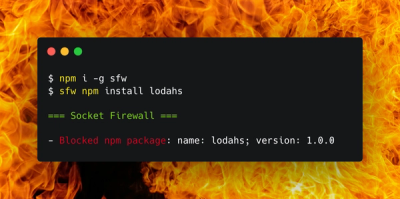
Product
Introducing Socket Firewall: Free, Proactive Protection for Your Software Supply Chain
Socket Firewall is a free tool that blocks malicious packages at install time, giving developers proactive protection against rising supply chain attacks.
@apify/actor-templates
Advanced tools

This repository stores boilerplate templates and code examples for Apify Actor. The purpose of these templates is to help devlopers get started with actor development on the Apify platform.
You can start using the actor templates right away with the Apify CLI:
npx apify-cli create my-crawler
or
npm -g install apify-cli
apify create my-actor
After running the command you will be prompted to select one of the templates from the list displayed in your terminal. The available templates are:
Basic templates to start developing actors on the Apify platform using Node.js (JavaScript/Typescript), or Python. Just install the CLI and watch your actor run.
You can find more code examples in the Apify SDK documentation.
If you're already familiar with Actors, you can use the following templates to bootstrap new projects using an empty project templates or Crawlee templates:
Start a new web scraping project quickly and easily in JavaScript/TypeScript (Node.js) or Python with our empty project template. It provides a basic structure for the Actor with Apify JavaScript SDK or Apify Python SDK and allows you to easily add your own functionality.
To run the template:
cd my-actor
apify run
The template manifest can be fetched programmatically. Apify CLI uses this to always fetch the most up to date templates.
npm i @apify/actor-templates
const templates = require("@apify/actor-templates");
const manifest = await templates.fetchManifest();
All templates are stores in ./templates directory.
For each template needs to create an archive of whole source code into the ./dist/templates directory.
The archive is used to create a boilerplate template in apify CLI or other places in the Apify system.
If you want to change a template, you will have to update the template files and the manifest.json file before pushing the changes to the master branch. After pushing to master, the archive will be automatically built using Github actions.
Templates are propagated to Apify CLI templates. You can then find your newly added template when using the apify create command.
The propagation happens after committing a new version of the template into the master branch. After tests succeeded the Github action
builds archives of each template and pushes these archives into the repository. The CLI command then uses those archives
to bootstrap your project folder. We did it this way because we can update template structure/code without publishing
any package to npm. It makes templates changes agile.
If you have any ideas for improvements, either submit an issue or create a pull request. For contribution guidelines and the code of conduct, see CONTRIBUTING.md.
FAQs
A manifest of Apify actor templates.
The npm package @apify/actor-templates receives a total of 2,388 weekly downloads. As such, @apify/actor-templates popularity was classified as popular.
We found that @apify/actor-templates demonstrated a not healthy version release cadence and project activity because the last version was released a year ago. It has 10 open source maintainers collaborating on the project.
Did you know?

Socket for GitHub automatically highlights issues in each pull request and monitors the health of all your open source dependencies. Discover the contents of your packages and block harmful activity before you install or update your dependencies.

Product
Socket Firewall is a free tool that blocks malicious packages at install time, giving developers proactive protection against rising supply chain attacks.

Research
Socket uncovers malicious Rust crates impersonating fast_log to steal Solana and Ethereum wallet keys from source code.

Research
A malicious package uses a QR code as steganography in an innovative technique.